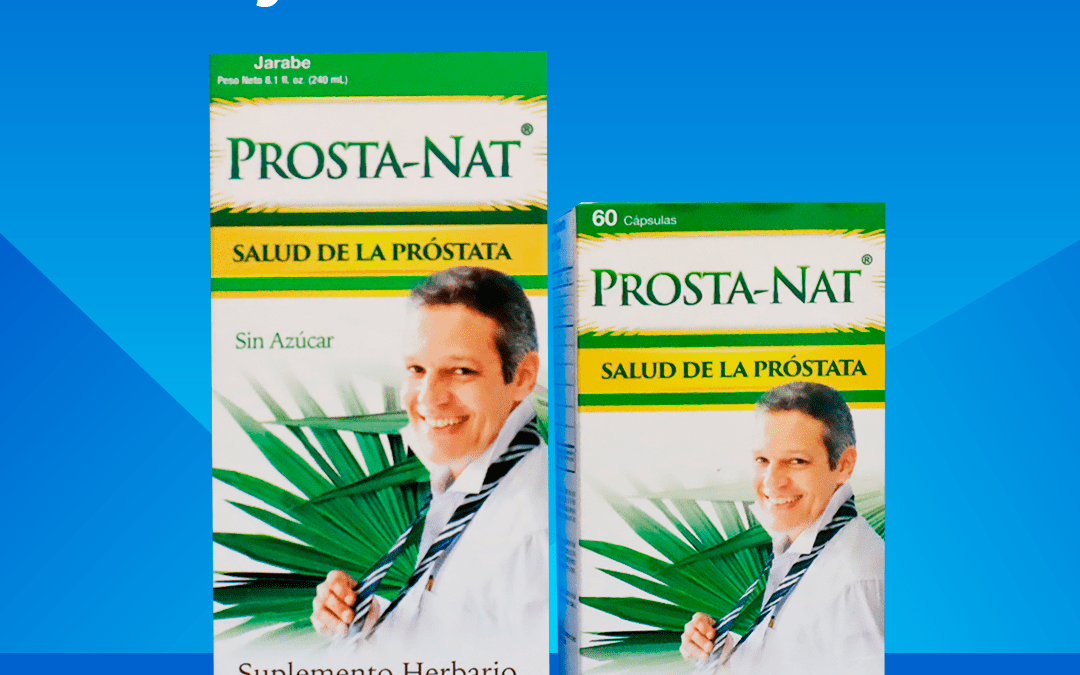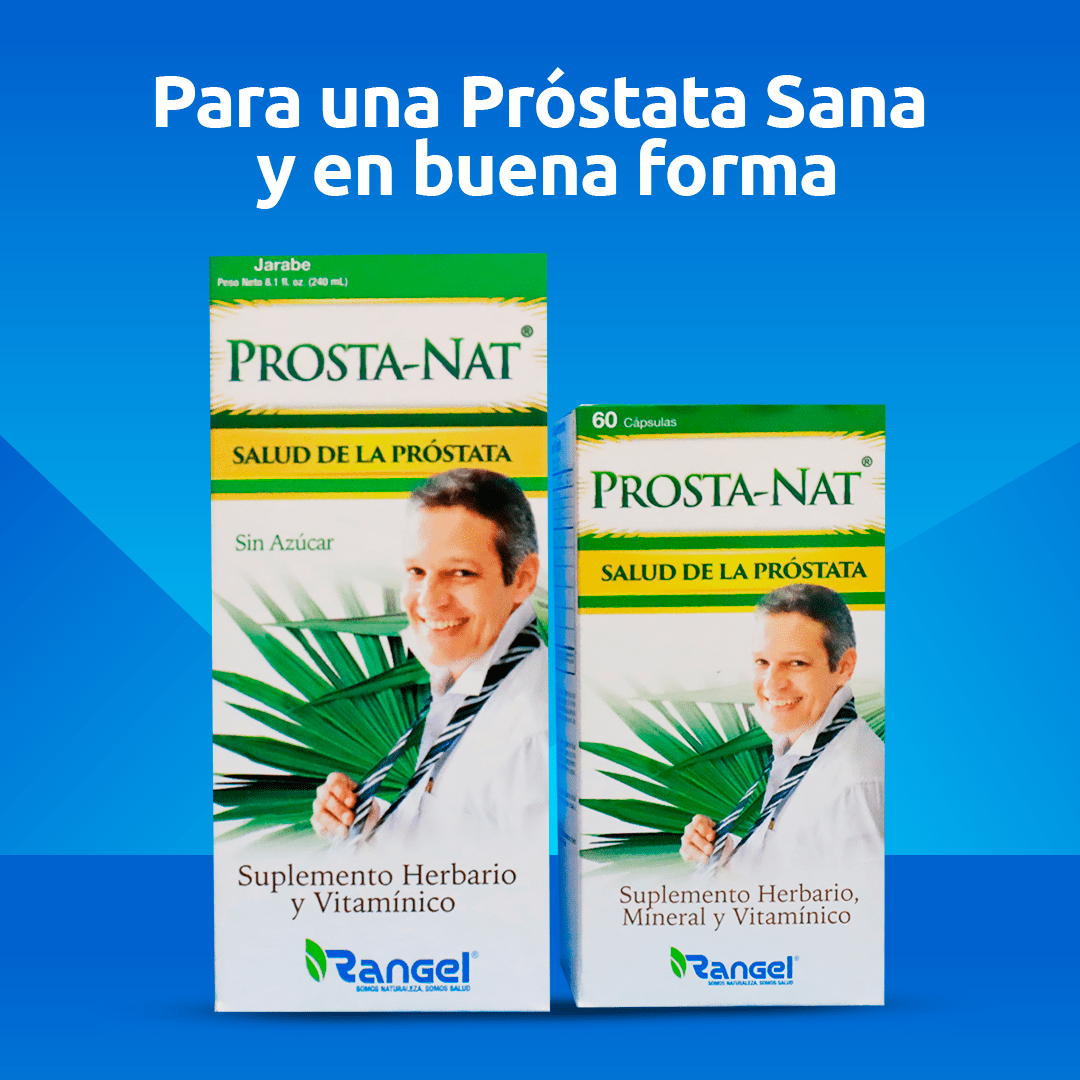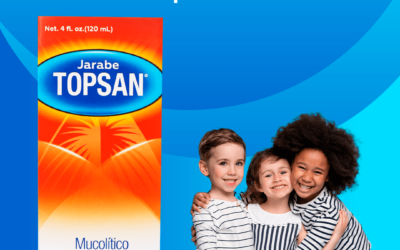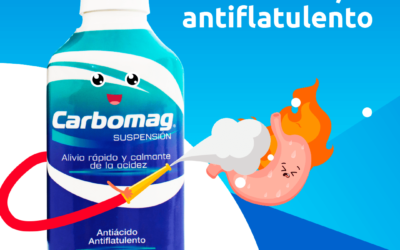TOPSAN-D Descongestionante Antitusivo-Antihistamínico TOPSAN-D, contiene en su fórmula la combinación de un...

PROSTA-NAT
PROSTA-NAT
Salud de la Próstata
Prosta-Nat, es un suplemento herbario y vitamínico que contribuye al restablecimiento de los desórdenes causados por la próstata, gracias a la acción combinada de sus componentes sobre la hiperplasia prostática, la prostatitis y las molestias al orinar causadas por estas dos enfermedades, además de constituir un producto preventivo antioxidante para evitar complicaciones en la salud de la próstata.
Ingredientes que lo componen:
Específicaciones técnicas
Tamaño por Ración: 2 cucharaditas (10 mL)
| Cantidad por la porción | %Valor Diario | |
| Vitamina E | 0.5 mg | 2% |
| Vitamina B6 | 1.25 mg | 62.5% |
| Vitamina B12 | 4.0 mg | 70.0% |
| Sulfato de zinc | 0.5 mg | + |
| Extracto de Saw Palmetto | 25.0 mg | + |
| Extracto de Cola de Caballo | 7.5 mg | + |
| Extracto de Achiote | 6.25 mg | + |
| Extracto de Jengibre | 7.5 mg | + |
| Extracto de Tomate | 11.5 mg | + |
| Extracto de Cebolla | 3.75 mg | + |
Porcentaje de valor diario basado en una dieta de 2000 calorías.
+Valor diario no establecido.Fórmula basada en 5 mL.
Dosis Sugerida:
En estados severos agudos de hiperplasia prostática o prostatitis, se recomienda tomar 2 cucharadas (10 mL cada una) dos veces al dia, 30 minutos antes de las comidas (comida y cena), durante 3 meses. como dosis de mantenimiento o preventiva esta dosis se puede reducir a la mitad (1 cucharada antes de las comida).
Cápsulas: Tomar 2 cápsulas 2 veces al día, 30 minutos antes de cada comida.
Via de administracion: Oral.
Advertencias y Precauciones: Mantener fuera del alcance de los niños.
Agitar el contenido del frasco antes de usar.
Contraindicaciones: Hipersensibilidad a los componentes de la fórmula.
Efectos Adversos: De forma poco frecuente se pueden presentar náuseas, dolor estomacal, mal aliento, constipación, diarrea o vómito. En caso de presentarse algunos de estos síntomas, se debe suspender la ingesta del suplemento.
Interacciones Medicamentosas: puede interactuar con medicamentos que provocan irritación de la mucosa gástrica como la aspirina el ibuprofeno y el naproxeno. Debe evitarse el uso simultáneo con formulaciones que contengan extractos de Ginkgo Biloba y Ajo.
Condiciones de Conservación: Almacenar por debajo de 30°C, proteger de la luz y la humedad.
Medidas en caso de intoxicación: Diríjase inmediatamente a su médico o al centro de salud más cercano.
Presentación del Producto:
Caja conteniendo frasco con 240 mL y frasco con 360 mL de jarabe.
- Avins AL.et al. (2008). “A detailed safety assessment of a saw palmetto extract” Complem Ther Med 16(3), 147-154.
- Bent S. et al. (2006) “Saw palmetto for benign prostatic hyperplasia” New Engl J Med 354(6), 557-566.
- Bhowmik D. et al. (2012) “Tomato-a natural medicine and its health benefits” J Pharmacogn Phytochem 1(1): 33-43.
- Bradley PR. (1992) British Herbal Compendium. A handbook of scientific information on widely used plant drugs. Companion of the British Herbal Pharmacopoeia. British Herbal Medicine Association.
- Enciso Gutierrez J et al. (2010) “Actividad antioxidante del extracto hidro-alcohólico de cuatro plantas medicinales y estimulación de la proliferación de fibroblastos” Rev. Soc. Quím (Perú) 76: 73-79.
- Ferrís J. et al (2011) “Factores de riesgo ambientales no dietéticos en el cáncer de próstata” Actas Urol Españolas 35(5): 289-295.
- Forrellat M. et al (1999) “Vitamina B12: metabolismo y aspectos clínicos de su deficiencia” Rev Cub Hematol Inmunol Hemoter 15(3): 159-174.
- Garay JB. (2006) “Anemias carenciales II: anemia megaloblástica y otras anemias carenciales” Información Terapéutica del Sistema Nacional de Salud (España) 30(3), 67-75.
- German Commission E Monographs en www.buecher.heilpflanzen-welt.de/BGA-Commission-E-Monographs/
- Helen A. et al (2000) “Antioxidant effect of onion oil (Allium cepa. Linn) on the damages induced by nicotine in rats as compared to alpha-tocopherol” Toxicol Lett 116: 61-68.
- Huaman O. et al (2009) “Efecto antiulceroso del extracto hidroalcohólico liofilizado de hojas de Bixa orellana (achiote) en ratas” An. Fac. Med. [online]. 70(2): 97-102.
- Marks LS. et al (2000) “Effects of a saw palmetto herbal blend in men with symptomatic benign prostatic hyperplasia” J Urology 163(5), 1451-1456.
- Martínez‐Valverde I. et al (2002). “Phenolic compounds, lycopene and antioxidant activity in commercial varieties of tomato (Lycopersicum esculentum)” J Sci Food Agric 82(3): 323-330.
- Nitta A. et al (1977) “A comparative study of crude drugs in Southeast Asia. X. Crude drugs derived from Equisetum species” Chem Pharm Bull (Japan) 25(5), 1135-1139.
- Ojewole JA. (2006) “Analgesic, antiinflammatory and hypoglycaemic effects of ethanol extract of Zingiber officinale (Roscoe) rhizomes (Zingiberaceae) in mice and rats” Phytother Res 20(9), 764-772.
- Pardo Arquero VP. (2004) “La Importancia de las Vitaminas en la Nutrición de Personas que Realizan Actividad Físico-deportiva” Rev Int Med Cienc Act Fis Deporte 4(16): 233-242.
- Prakash J. (2010) “Chemical composition and antioxidant properties of ginger root (Zingiber officinale)” J Med Plants Res 4(24), 2674-2679.
- Price KR, Rhodes MJC. (1997) “Analysis of the Major Flavonol Glycosides Present in Four Varieties of Onion (Allium cepa) and Changes in Composition Resulting from Autolysis” J Sci Food Agric 74: 331-339.
- Rodríguez B, Rodríguez EM, Díaz C. (2008) “Flavonoids in Onion Cultivars (Allium cepa L.)” J Food Sci 73: C599–C605.
- Terry R. et al (2011) “The use of ginger (Zingiber officinale) for the treatment of pain: a systematic review of clinical trials” Pain Med 12(12), 1808-1818.
- Yarnell E, Abascal K. (2005) “Natural Approaches to Treating Chronic Prostatitis and Chronic Pelvic Pain Syndromes” Altern Complem Ther 11(5): 246-251.
- Zegarra L. et al (2007).”Double-blind randomized placebo-controlled study of bixa orellana in patients with lower urinary tract symptoms associated to benign prostatic hyperplasia” International Braz J Urol, 33(4): 493-501.











